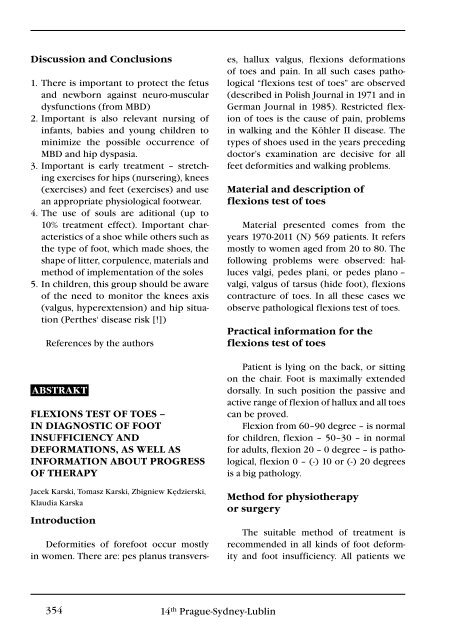3+4+Supplementum/2012 - Společnost pro pojivové tkáně
3+4+Supplementum/2012 - Společnost pro pojivové tkáně
3+4+Supplementum/2012 - Společnost pro pojivové tkáně
- TAGS
- www.pojivo.cz
You also want an ePaper? Increase the reach of your titles
YUMPU automatically turns print PDFs into web optimized ePapers that Google loves.
discussion and Conclusions<br />
1. There is important to <strong>pro</strong>tect the fetus<br />
and newborn against neuro-muscular<br />
dysfunctions (from MBD)<br />
2. Important is also relevant nursing of<br />
infants, babies and young children to<br />
minimize the possible occurrence of<br />
MBD and hip dyspasia.<br />
3. Important is early treatment – stretching<br />
exercises for hips (nursering), knees<br />
(exercises) and feet (exercises) and use<br />
an ap<strong>pro</strong>priate physiological footwear.<br />
4. The use of souls are aditional (up to<br />
10% treatment effect). Important characteristics<br />
of a shoe while others such as<br />
the type of foot, which made shoes, the<br />
shape of litter, corpulence, materials and<br />
method of implementation of the soles<br />
5. In children, this group should be aware<br />
of the need to monitor the knees axis<br />
(valgus, hyperextension) and hip situation<br />
(Perthes‘ disease risk [!])<br />
References by the authors<br />
aBSTRakT<br />
flexiOnS TeST Of TOeS –<br />
in diaGnOSTiC Of fOOT<br />
inSuffiCienCY and<br />
defORMaTiOnS, aS well aS<br />
infORMaTiOn aBOuT PROGReSS<br />
Of THeRaPY<br />
Jacek Karski, Tomasz Karski, Zbigniew Kędzierski,<br />
Klaudia Karska<br />
introduction<br />
Deformities of forefoot occur mostly<br />
in women. There are: pes planus transvers-<br />
354 14 th Prague-Sydney-Lublin<br />
es, hallux valgus, flexions deformations<br />
of toes and pain. In all such cases pathological<br />
“flexions test of toes” are observed<br />
(described in Polish Journal in 1971 and in<br />
German Journal in 1985). Restricted flexion<br />
of toes is the cause of pain, <strong>pro</strong>blems<br />
in walking and the Köhler II disease. The<br />
types of shoes used in the years preceding<br />
doctor’s examination are decisive for all<br />
feet deformities and walking <strong>pro</strong>blems.<br />
Material and description of<br />
flexions test of toes<br />
Material presented comes from the<br />
years 1970-2011 (N) 569 patients. It refers<br />
mostly to women aged from 20 to 80. The<br />
following <strong>pro</strong>blems were observed: halluces<br />
valgi, pedes plani, or pedes plano –<br />
valgi, valgus of tarsus (hide foot), flexions<br />
contracture of toes. In all these cases we<br />
observe pathological flexions test of toes.<br />
Practical information for the<br />
flexions test of toes<br />
Patient is lying on the back, or sitting<br />
on the chair. Foot is maximally extended<br />
dorsally. In such position the passive and<br />
active range of flexion of hallux and all toes<br />
can be <strong>pro</strong>ved.<br />
Flexion from 60–90 degree – is normal<br />
for children, flexion – 50–30 – in normal<br />
for adults, flexion 20 – 0 degree – is pathological,<br />
flexion 0 – (-) 10 or (-) 20 degrees<br />
is a big pathology.<br />
Method for physiotherapy<br />
or surgery<br />
The suitable method of treatment is<br />
recommended in all kinds of foot deformity<br />
and foot insufficiency. All patients we

















